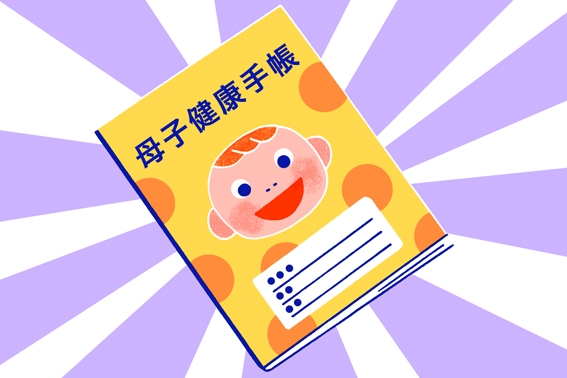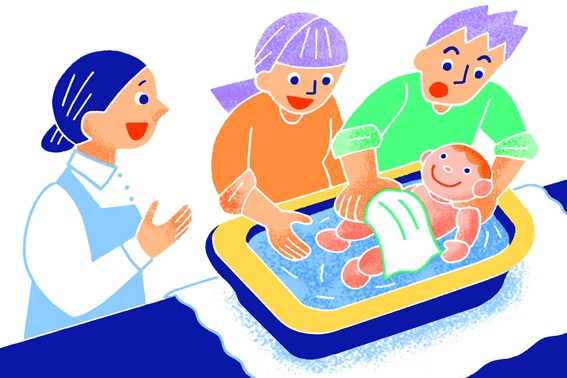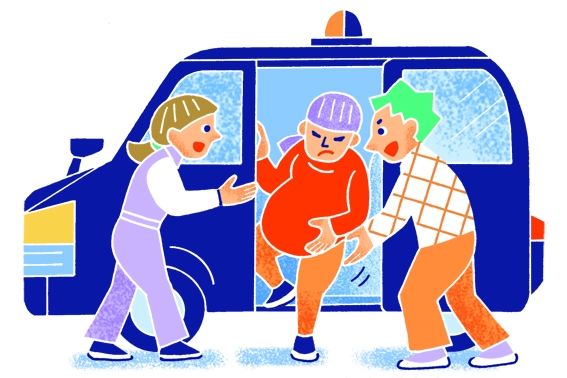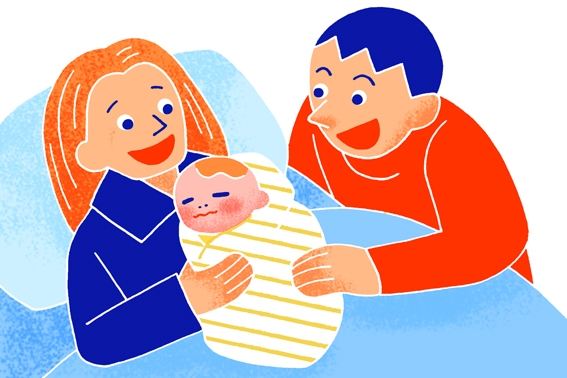- Pregnancy
- Mother and Child Handbook (boshi techo)
- Prenatal checkups
- Childbirth
- After childbirth
- Consultation for pregnancy, childbirth, and parenting
Pregnancy

Having a baby in your womb is called “pregnancy (nin shin).”
If you think you might be pregnant, go see an obstetrician and gynecologist.
Look for a hospital to deliver your baby if the doctor confirms your pregnancy.
Make an appointment with a hospital for an "obstetrics (san ka)" as soon as possible.
Mother and Child Handbook (boshi techo)
Once you learn of your pregnancy, submit a “Notification of Pregnancy” to your local municipal office as soon as possible.
You will receive a "Mother and Child Handbook", tickets for prenatal checkups, information about prenatal classes, and more after submitting your pregnancy notification.
[What is “Mother and Child Handbook (Mother and Child Health Handbook)”]

The "Mother and Child Handbook" is an important notebook for recording the following:
- Whether you, expecting mother, and your unborn baby are healthy
- How your newborn has been growing
- Type of sickness your child got and when
- What vaccinations your child has received
Keep up with health records of your child from the time in your womb until entering elementary school on your “Mother and Child Handbook”.
Some cities may prepare “Mother and Child Health Handbook” in foreign languages. If you would like to have one in a foreign language, ask your local municipal office whether they have one.
Prenatal checkups
A mother with a baby in her womb is called a “pregnant woman (nin pu).”
A “Health checkup (ken shin)” is to check if you are healthy or not sick.
Receive "prenatal checkups (nin pu ken shin)" at a hospital to check whether you, e xpecting mother, and the baby in your womb are healthy.
You will have prenatal checkups about 14 times until the childbirth.
You will pay reduced fees for prenatal checkups if you use the prenatal checkup ticket provided at the municipal office.
[Frequency of prenatal checkups]
- Up to 23 weeks of pregnancy: every 4 weeks
- 24 to 35 weeks of pregnancy: every 2 weeks
- From 36 weeks of pregnancy until childbirth: once a week
Prenatal class (or prenatal class for couples)

“Prenatal class (hahaoya gakkyu)” is for pregnant women who to learn how to live during their pregnancy and how to care for their babies.
Prenatal classes are provided by municipal offices and hospitals.
Recently, the number of “prenatal classes for couples (ryoshin gakkyu)” that fathers can participate with the pregnant mother have become more available.
You can make friends who also will have newborn babies around the same time as you while participating in the prenatal classes.
Childbirth

In Japan, you are hospitalized for about five days for childbirth.
Be prepared to go to the hospital at any time when you are about eight months of pregnancy.
The hospital will inform you what you need to bring to stay in the hospital.
Plan beforehand how to get to the hospital when labor pain starts.
[Lump-Sum Childbirth and Childcare Allowance]
Giving birth to a baby is called “childbirth (shussan).”
Hospitalization for childbirth costs about 500,000 yen. Your health insurance does not cover any of this cost since your hospitalization is not for illness.
However, some costs for childbirth will be paid by the municipal if you have enrolled in a health insurance plan.
This money is called the "lump-sum childbirth and childcare allowance (shussan ikuji ichiji kin)," and you can receive 500,000 yen.
Go through the procedures at the hospital for this allowance before you deliver a baby.
After childbirth

Submit a “notification of birth (shussei todoke)” to the municipal office within 14 days from the day of the child’s birth.
If you are a foreign national and would like to obtain foreign nationality for your newborn, notify the embassy or consulate of your country.
Also, go through necessary procedures at the Immigration Bureau (nyukan) and receive a residence card.
For more details, please see here ⇒ "Procedures when a child is born"
[Birth notification postcard]
A “birth notification postcard (shussei tsuchi hyo)” is a postcard used to notify the local public health department of the birth of your baby.
You receive it together with the “Mother and Child Handbook”.
Information for infant checkups, vaccinations, and newborn home-visit consultations will be sent to you if you submit it.
As soon as the baby is born, submit the birth notification postcard to your local public health department, public health center, or municipal office.
Consultation for pregnancy, childbirth, and parenting
You can consult with a public health nurse or midwife if you have any worries or problems during pregnancy or after giving the birth.
Ask about this service at the public health department or public health center near your home.
Tokyo Metropolitan Government Bureau of Public Health: List of wards’ public health departments and public health centers (machine translation available [13 languages])
Tokyo Metropolitan Government Bureau of Public Health: List of municipal public health centers (machine translation available [13 languages])












